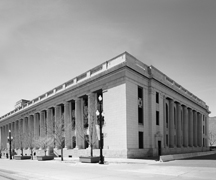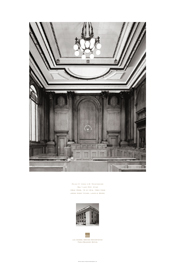Location: 350 S Main St, Salt Lake City, UT 84101
History
The Frank E. Moss U.S. Courthouse (originally known as the U.S. Post Office and Courthouse) is the oldest building in Salt Lake City’s Exchange Place Historic District. The district consists of eight buildings, constructed between 1903 and 1917, that reflect Utah’s growing prosperity at the end of the nineteenth century.
After Utah became a state in 1896, planning began for a federal building in the capital city. The following year, Congress appropriated $500,000 for site acquisition and building construction. The selected site was purchased from two local bankers, the Walker brothers, for one silver dollar on November 21, 1899.
The Classical Revival style building was designed by the Office of the Supervising Architect of the Treasury Department headed by James Knox Taylor. Construction began in the summer of 1902. Flaws in the stonework delayed construction, but the U.S. Post Office and Courthouse was finished in late 1905. An addition, which echoed the style of the original building, was constructed on its west (rear) side between 1910 and 1912.
In the late 1920s another addition was planned under the direction of Louis A. Simon, Superintendent of the Architectural Section of the Treasury Department. The design was intended to duplicate the earlier facades, but an unforeseen problem arose. During construction of the building’s final addition, extensive cracking and spalling were discovered in the soft Kyune sandstone that faced the 1905 and 1912 sections. As a consequence, the addition was constructed entirely in granite and nearly all the existing facades were refaced to match. Work was completed in 1932.
In 1990 the courthouse was renamed in honor of Frank Edward Moss, a Utah native who served as U.S. Senator from 1959 to 1977. The Exchange Place Historic District, including the Frank E. Moss U.S. Courthouse, was added to the National Register of Historic Places in 1978. This district is also listed as a historic landmark on the Salt Lake Register of Cultural Resources.
Architecture
Located on Main Street in Salt Lake City’s Exchange Place Historic District, the U.S. Post Office and Courthouse, now the Frank E. Moss U.S. Courthouse, helped introduce the Classical Revival style to Utah. The original building was constructed between 1902 and 1905 with a U-shaped plan. The two additions, completed in 1912 and 1932, closed the end of the U and added another U-shaped section. Together they form a plan with a figure-eight shape, enclosing a pair of light courts. When the last addition was constructed, the Classical Revival style was reinterpreted as a form of modern classicism that was prevalent for many public buildings of the 1930s.
The building rises five full stories above a basement and has a central two-story penthouse. The exterior walls of the 1905 and 1912 sections were originally clad in Kyune sandstone that experienced significant cracking and other damage over the years. These walls were refaced with Utah granite during the construction of the final addition. The only original sandstone wall surface remaining is on one of the eight internal light court elevations.
Because much of the original sandstone was replaced in 1932, the classically designed exterior displays elements of stylized modern classicism. Broad granite steps lead from the street to the courthouse’s main entrance, along its east elevation. Flanking the steps are granite railings with streamlined detailing and eagles with outstretched wings. Atop the bronze entry doors are elaborate decorative grilles of bronze and aluminum.
A colonnade of fifteen fluted, engaged Doric columns spans the eastern facade, supporting a classical entablature and parapet with balustrade. Three-story high window openings are recessed behind the columns. In each bay, just below the third floor, is a decorative metal screen set on marble backing.
The north elevation is similar in style but not as wide with seven columns and ten window bays. Its three westernmost bays have wood spandrels and pediments in place of marble-backed metal screens. The south elevation, also ten bays wide, is simpler in design, having rectangular pilasters rather than the engaged columns of the north and east elevations.
The rear of the building, which faces west, presents the simplest elevation. It differs from the other three elevations, having neither columns nor pilasters, as it was intended to be the least visible when built. It is faced in yellow brick with a sandstone belt course. The north side of this elevation, which dates from the 1912 extension, has sandstone trim, while its south side, added in 1932, employs terra cotta for the window lintels and other elements. The internal light court elevations are also faced in yellow brick, except for the south elevation of the original building. It retains its intricately carved pilasters and capitals. This elevation originally faced the street.
Inside the courthouse, the floors of the main lobby and corridors are a combination of marble, tile, and terrazzo. Marble wainscoting appears throughout the 1905 portion of the courthouse. Three original courtrooms, located on the second floor, have retained much of their original appearance. They are two stories high, with oak wainscot and paneling, as well as ornamental plaster ceilings with decorative coffers.
To accommodate the expanding needs of U.S. District Court in the District of Utah, in 2010 GSA received $185M for the construction of a new Courthouse to be located on a site directly adjacent to the existing Frank E Moss U.S. Courthouse. In order to accomplish this, GSA successfully relocated the historic Odd Fellows Building from the site to its current location on Market Street. The Courthouse broke ground in January 2011 and was completed in March 2014.
This new U.S. Courthouse was officially renamed the Orrin G. Hatch U.S. Courthouse in September, 2021 and is connected by a tunnel to the Frank E. Moss Courthouse, which is situated adjacent to and directly east of the new building. In 2016, as a result of Executive Order 13717, Establishing a Federal Earthquake Risk Management Standard, the Frank E. Moss U.S. Courthouse was ranked as GSA’s most at-risk property in the country due to its original structural design and location along the increasingly active Wasatch fault line.
In 2019, GSA received authorization to invest $116M into the historic Frank E. Moss Courthouse to seismically stabilize the historic structure. In addition, the project will address major building systems which have reached the end of their useful life and back-fill the newly renovated space with 12 federal agencies primarily located in private market leases, saving taxpayers $4.3M annually in private market rental costs.
The project’s design will save 6.4M kgCO2e (57%) by capitalizing on low embodied carbon materials and building preservation. In addition, the investment will realize a 52% energy reduction and convert Moss to an all-electric building, making it Net Zero Operational Carbon when coupled with renewable energy from the utility. The modernization of the Frank E. Moss U.S. Courthouse is expected to be complete in 2025.
Significant Events
- 1896: Utah becomes a state, and planning for a federal building in Salt Lake begins.
- 1899: The building site is purchased for one silver dollar.
- 1902-1905: The U.S. Post Office and Courthouse is constructed.
- 1910-1912: An addition is made to the west side of the building.
- 1932: A U-shaped addition to the south side gives the building its present plan; most of existing structure is refaced in granite.
- 1978: The building is listed in the National Register of Historic Places as part of the Exchange Place Historic District.
- 1990: The U.S. Courthouse is renamed in honor of Frank Moss, three-term U.S. Senator from Utah.
- 2016: The issuance of Executive Order 13717, Establishing a Federal Earthquake Risk Management Standard, catapulted the Frank E. Moss U.S. Courthouse to the top of GSA’s list of at-risk properties.
- 2019: GSA received $116M to seismically stabilize, backfill, preserve, and modernize the Frank E Moss U.S. Courthouse.
- 2020: In August, GSA awarded the design of the modernization to the globally recognized and award winning design firm, Hellmuth Obata & Kassabaum (HOK).
- 2022: In April, GSA awarded the construction contract to locally operated Big-D Construction.
- 2025: The Frank E. Moss U.S. Courthouse will be reopened to serve the public as it has since 1905, housing 12 federal agencies, most notably the U.S. Bankruptcy Court and U.S. Citizenship and Immigration Services.
Facts
- Architect: James Knox Taylor, Supervising Architect of the Treasury Department; Louis A. Simon, Superintendent of the Architecture Section
- Architectural Style: Classical Revival; Modern Classicism
- Construction Dates: 1902-1905; additions 1910-1912 and 1930-1932
- GSA Building Number: UT0017ZZ
- Landmark Status: Listed in the National Register of Historic Places as part of the Exchange Place Historic District (the district is also a Salt Lake City Historic Landmark)
- Primary Materials: Granite, sandstone, and terra cotta
- Prominent Features: Fluted Doric colonnade; Decorative grilles on entrance doors
Poster Download
Download the poster [PDF - 1 MB]

 U.S. General Services Administration
U.S. General Services Administration

